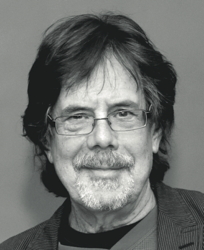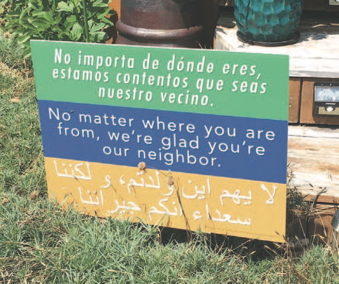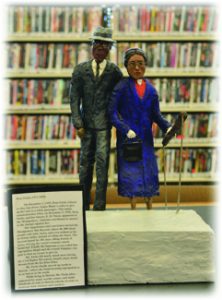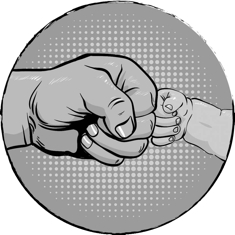By PETER WERBE
 ACROSS THE CITIES SERVED BY FERNDALE FRIENDS, lawn signs are displayed welcoming immigrants to our communities. What they proclaim are an echo of he familiar words mounted on the base of the Statue of Liberty—“Give me your tired, your poor. . .”
ACROSS THE CITIES SERVED BY FERNDALE FRIENDS, lawn signs are displayed welcoming immigrants to our communities. What they proclaim are an echo of he familiar words mounted on the base of the Statue of Liberty—“Give me your tired, your poor. . .”
In Ferndale, Oak Park and beyond, the signs on our lawns state in three languages, “No matter where you are from, we’re glad you’re our neighbor.” These public pronouncements define communities committed to diversity, tolerance, and a charity of heart.
The “mighty woman with a torch,” as the full poem reads, reaches 305 feet into the sky, calling out a welcome to the “huddled masses” and “wretched refuse” to our shores.
Wonderful words, but rarely honored as we are witnessing today at the U.S. southern border. American history wasn’t much better on welcoming immigrants to our country either. In fact, from the first wave of European migrants, the new arrivals were despised and discriminated against.
Other than those from Northern Europe, many of our ancestors were accused of being the source of crime, disease, and social unrest, much in the way those from Central and South America are today by some. Although, it is well-known that current immigrants commit less crime than those born here, this doesn’t stop right-wing politicians from whipping up frightened Americans with images of criminal gangs and job theft.
The lower crime rate is actually somewhat surprising. Earlier ethnic groups often were disproportionately represented in law-breaking. The Irish (part of my heritage) were the targets of great discrimination, giving rise to signs saying, “No Irish need apply” at job sites, leading to lives of poverty and high crime rates.
Following their mass migration here in the 1840s and ‘50s, so many poor Irishmen were hauled off to jail that the police vehicle employed was dubbed a Paddy Wagon, using the word which became an anti-Irish slur stemming from the nickname for Pádraig (Patrick when Anglicized). And, just as the racist stereotyping of all Muslims results from the actions of a tiny fraction of those of the faith, so too were Irish thought to be more loyal to the Pope in Rome than their new country.
This was reinforced during the 1846-48 U.S. ware against Mexico, when hundreds of newly arrived Irishmen were gang-pressed into the American army. Hundreds of Dubliners deserted from the U.S. war of aggression and fought on the Mexican side, organizing themselves as the St. Patrick’s Battalion. These “red-headed fighters” battled American troops alongside the Mexican army from Metamoros to San Diego, finally falling to “the cannons from Boston,” as David Rovics’ lyrics puts it in his song about the Battalion. (Available at DavidRovics.com.)
As an aside, when condemning Russia’s inexcusable annexation of Crimea and eastern Ukraine, we should consider the massive territory theft of Mexican territory—California, Arizona, New Mexico, and Texas. Putin’s moves are small change compared to that.
Other immigrating ethnic groups fared no better, being seen by the native born as people constantly under suspicion of crime and political radicalism. This included groups such as Jews (part of my heritage) and Italians, who upon arriving provided enough of their members involved in both to maintain stereotypes.
Although only an infinitesimal small number participated in criminal gangs, Italians in the Mafia and Jews in mobs like Detroit’s Purple Gang, they were often held to be representative of the entire nationality. For instance, in 1908, the New York City police commissioner claimed erroneously that half of the city’s criminals were Jewish.
Many Jewish immigrants were members of communist, socialist, and anarchist groups during the early years of the 20th Century, fueling anti-Semitism and a perception of disloyalty. Some recently arrived Italians were part of violent anarchist groups that carried out a string of bombings in the WWI era, including targeting Wall Street, and the homes of the U.S. Attorney General, and oil magnate, John D. Rockefeller.
Legislation such as the 1882 Chinese Exclusion Act and the Immigration Act of 1924 gave lie to the Lady of the Harbor’s call to “Send these, the homeless, tempest-tossed to me.”
PEOPLE NOT WELCOMED, HELD IN CONTEMPT, DISCRIMINATED AGAINST, and stereotyped, find it difficult to integrate into their new homeland – which is why the signs appearing on our lawns are so important. In the tumultuous days of the early 20th Century, there was no one to say, “We’re glad you’re our neighbor.”
The early immigration waves came as a result of wars, famine, and poverty, and it is no less so today with those crossing the border from South and Central America. Rather than erecting a wall as a ridiculous way to stem illegal immigration, how about enacting a hemisphere-wide minimum wage of $15? Workers from Detroit to Guadalajara would see a rise in their standard of living and the corporations which currently benefit from paying slave wages would pay for it.
This alone would go a long way towards staunching the poverty and violence that is endemic to poor regions and cities, and could end the tide of migration. The poverty and violence of a century ago and that of today is what impels waves of immigrants to flee their homeland.
A huge redistribution of wealth in the form of an increased wage might mean that Richie Rich Guy won’t be able to buy a second Maserati or own his own island, but prosperity for all is the key to having stable, livable cities and countries.
So, let’s keep those signs up until our brothers and sisters from the Middle East, Africa, and Latin America are allowed to take their place in our society in the same manner as were our forebears.
Peter Werbe is a member of the Fifth Estate magazine’s editorial collective www.FifthEstate.org.



 mother and she threw holy water at us. I thought it was ‘interesting’ and, as two film students at the time, we wrote it on a sticky note to add it in a potential short film. Two weeks later, she tried to force feed us ‘holy grapes’ and you can say the book wrote itself. We had offers from publishing houses with horrible contracts, so we decided to self-publish to have more freedom in what we write and produce.
mother and she threw holy water at us. I thought it was ‘interesting’ and, as two film students at the time, we wrote it on a sticky note to add it in a potential short film. Two weeks later, she tried to force feed us ‘holy grapes’ and you can say the book wrote itself. We had offers from publishing houses with horrible contracts, so we decided to self-publish to have more freedom in what we write and produce.
 for students of all ages. Oak Park schools truly provide a great educational experience for students with various abilities. The goal is for all students to reach their full potential. We are closing the opportunity gap. We are working daily to increase student achievement while providing exposure and opportunity that removes barriers that hinder success. Oak Park schools has a caring and committed workforce, as well as very dedicated employee partners. We also have a very supportive resident and business community.
for students of all ages. Oak Park schools truly provide a great educational experience for students with various abilities. The goal is for all students to reach their full potential. We are closing the opportunity gap. We are working daily to increase student achievement while providing exposure and opportunity that removes barriers that hinder success. Oak Park schools has a caring and committed workforce, as well as very dedicated employee partners. We also have a very supportive resident and business community. InsideOut is Detroit’s largest literary arts non-profit and Oak Park Schools has had the honor of working with the non-profit for four consecutive years. Since 1995, InsideOut has helped more than 50,000 Detroit youth express themselves through the written word. The InsideOut Poetry Gala featured OPPA students reciting their work, and staff sharing some of their favorite selections from the book.
InsideOut is Detroit’s largest literary arts non-profit and Oak Park Schools has had the honor of working with the non-profit for four consecutive years. Since 1995, InsideOut has helped more than 50,000 Detroit youth express themselves through the written word. The InsideOut Poetry Gala featured OPPA students reciting their work, and staff sharing some of their favorite selections from the book. their classrooms fully equipped with 21st Century learning tools when they return on Tuesday, August 29, 2018. Interactive projection screens called Promethean Boards, and laptop carts will be available. These tools are designed to keep students engaged while enhancing their technology skills and overall learning environments.
their classrooms fully equipped with 21st Century learning tools when they return on Tuesday, August 29, 2018. Interactive projection screens called Promethean Boards, and laptop carts will be available. These tools are designed to keep students engaged while enhancing their technology skills and overall learning environments. Oak Park Schools, a school-of-choice district, has more than 5,000 students. Oak Park is a school-of-choice district. Students must be a resident of Oakland, Macomb, or Wayne Counties, between the grades of Pre-K-12, to attend.
Oak Park Schools, a school-of-choice district, has more than 5,000 students. Oak Park is a school-of-choice district. Students must be a resident of Oakland, Macomb, or Wayne Counties, between the grades of Pre-K-12, to attend.
 recognized as a model . Only approximately 200 schools nationwide and in Canada receive this honor. “PLCs are schools and districts in which educators recognize the key to improved learning for students is on-going, job-embedded learning for the adults who serve those students,” Jones explained. Educators focus on learning, build a collaborative culture, and create a results orientation.
recognized as a model . Only approximately 200 schools nationwide and in Canada receive this honor. “PLCs are schools and districts in which educators recognize the key to improved learning for students is on-going, job-embedded learning for the adults who serve those students,” Jones explained. Educators focus on learning, build a collaborative culture, and create a results orientation. Champions. Coach Greg Carter and the athletic staff led the students to victory.
Champions. Coach Greg Carter and the athletic staff led the students to victory. competition on September 23, 2017, claiming victory over marching bands from six schools in the State of Michigan. The Marching Legion swept all six major categories, winning first place trophies in Overall Auxiliary, Overall Drum Major, Overall Drumline, Overall Music, Class A Band, and Overall Grand Champions. “The band’s motto is ‘Enthusiasm is the Key.’ When we are performing, we must always be enthusiastic about it. We believe that by embracing our motto we are able to offer performances everyone can enjoy and appreciate wholeheartedly,” said Mr. Virgil Goodwine, Band Director of the Marching Legion.
competition on September 23, 2017, claiming victory over marching bands from six schools in the State of Michigan. The Marching Legion swept all six major categories, winning first place trophies in Overall Auxiliary, Overall Drum Major, Overall Drumline, Overall Music, Class A Band, and Overall Grand Champions. “The band’s motto is ‘Enthusiasm is the Key.’ When we are performing, we must always be enthusiastic about it. We believe that by embracing our motto we are able to offer performances everyone can enjoy and appreciate wholeheartedly,” said Mr. Virgil Goodwine, Band Director of the Marching Legion. organization (Y.O.U.) sponsor; and teacher leader, was presented with the prestigious ‘Power of One’ Award at the Tri-Community Coalition’s 19th annual Leadership Breakfast held on December 8, 2017.
organization (Y.O.U.) sponsor; and teacher leader, was presented with the prestigious ‘Power of One’ Award at the Tri-Community Coalition’s 19th annual Leadership Breakfast held on December 8, 2017.

 explained Berkley Schools Communications Director Jessica Stilger. She added, “Its middle school, which includes grades 6 through 8, combines Oak Park residents with those from Huntington Woods. This school is very diverse in its student body socio-economically, racially, and religiously. The school is a current International Baccalaureate school.”
explained Berkley Schools Communications Director Jessica Stilger. She added, “Its middle school, which includes grades 6 through 8, combines Oak Park residents with those from Huntington Woods. This school is very diverse in its student body socio-economically, racially, and religiously. The school is a current International Baccalaureate school.” six-weeks-old through age five. The two centers collectively have infant, toddler and preschool classrooms that run both school-year and year-round schedules. The center houses state and federally funded preschool classrooms, including Great Start Readiness Program (GSRP) and Head Start. Enrollment for Building Blocks is not limited to Berkley School District boundaries. In Fall 2018, the two buildings will combine into one childcare center at Avery, after extensive work completes over the summer due to a 2015 Bond passage,” Stilger said.
six-weeks-old through age five. The two centers collectively have infant, toddler and preschool classrooms that run both school-year and year-round schedules. The center houses state and federally funded preschool classrooms, including Great Start Readiness Program (GSRP) and Head Start. Enrollment for Building Blocks is not limited to Berkley School District boundaries. In Fall 2018, the two buildings will combine into one childcare center at Avery, after extensive work completes over the summer due to a 2015 Bond passage,” Stilger said.
 “Ferndale offers a hometown, small school atmosphere that gives parents, students, and teachers, and community an opportunity to really get to know one another,” Good said. “The district is large enough to provide a wide range of curricular and extra-curricular offerings, but small enough to maximize student participation and maintain a community feel.”
“Ferndale offers a hometown, small school atmosphere that gives parents, students, and teachers, and community an opportunity to really get to know one another,” Good said. “The district is large enough to provide a wide range of curricular and extra-curricular offerings, but small enough to maximize student participation and maintain a community feel.” Pitts-Reed qualified for the state championship wrestling meet. Student athletes Jacob Keener and John Stellard were selected from a pool of more than 4,200 nominees to be among 16 finalists awarded the Michigan High School Athletic Association Scholar Athlete (MHSAA) award. Students continue to excel at sports, academics, and extra-curriculars each school year.
Pitts-Reed qualified for the state championship wrestling meet. Student athletes Jacob Keener and John Stellard were selected from a pool of more than 4,200 nominees to be among 16 finalists awarded the Michigan High School Athletic Association Scholar Athlete (MHSAA) award. Students continue to excel at sports, academics, and extra-curriculars each school year.
 early 1950s, the Oak Park Library was run out of a bookmobile, and the Friends raised over $24,000 by requesting supplies, furniture and funds door-to-door in Oak Park neighborhoods. As a result, the Library opened the doors to their building at 14300 Oak Park Blvd in 1958, and are still located there. The Friends continue to help with renovations too, supporting remodels in 1968 and 2011.
early 1950s, the Oak Park Library was run out of a bookmobile, and the Friends raised over $24,000 by requesting supplies, furniture and funds door-to-door in Oak Park neighborhoods. As a result, the Library opened the doors to their building at 14300 Oak Park Blvd in 1958, and are still located there. The Friends continue to help with renovations too, supporting remodels in 1968 and 2011.

